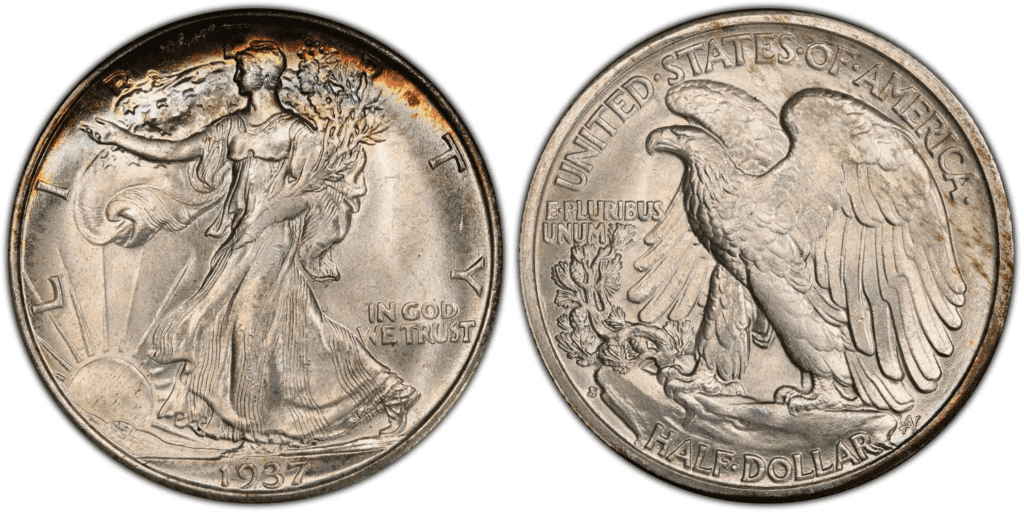What Is the 1937 Liberty Half Dollar Made Of?
Did you know that collectors still gather to this magnificent coin to get their hands on a fantastic piece of US coinage history, even though it is no longer being manufactured? Naturally, only the finest, best-preserved specimens will do for collectors, and obtaining the nearly century-old coins in perfect form is no easy task.
The 1937 Liberty half Dollar is a silver 50-cent coin or half-a-dollar coin. The United States Mint produced this beautiful coin between 1916 and 1947. The designer of this coin was an American architect and sculptor of German descent, Adolph A. Weinman.
The Liberty half Dollar has reeded edges with a thickness of 1.8 millimeters. The coin is 90% silver and 10% copper, with a silver content of 0.36169 troy oz. The coin weighs 12.50 grams and is 30.63 in diameter.

On the obverse side of the coin, the designs were: LIBERTY, sun on the eastern horizon, American flag held high, IN GOD WE TRUST, and the year of mintage.
The reverse side of the coin’s design includes: From its perch on a mountaintop, a bald eagle rises, UNITED STATES OF AMERICA, E PLURIBUS UNUM, and HALF DOLLAR.
In 1915, Woolley, Robert, the new Mint Director, began to feel that he had the legal authority to replace coin designs that had been in circulation for 25 years. As a result, he started replacing the Barber coinage, which included the dime, quarter, and half a dollar, all of which featured the same designs created by renowned Mint Engraver Barber Charles and were first produced in 1892. Then the Mint held a competition where Weinman’s design was chosen for half a dollar.
It was challenging to polish Weinman’s half-dollar design of Liberty marching toward the Sun. Treasury Secretary William G. McAdoo, whose department oversaw the Mint, pondered having Barber produce his design. The mint successfully put Weinman’s design into production, although it never struck properly, which may have contributed to its replacement by the Franklin half a dollar starting in 1948.
Nevertheless, art expert Cornelius Vermeule regarded the piece as one of the most attractive US coins. The American Silver Eagle coin has utilized a variant of Weinman’s obverse design since 1986, and the half-dollar was minted in gold for its centenary in 2016.
1937 Liberty Half Dollar Varieties
The 1937 Liberty has four varieties. These are the following:
| Variety | Mint Location | Mintage |
| 1937 D Liberty Half Dollar | Denver | 1,676,000 |
| 1937 S Liberty Half Dollar | San Francisco | 2,090,000 |
| 1937 P Liberty Half Dollar | Philadelphia | 9,522,200 |
| 1937 Proof Liberty Half Dollar | Philadelphia | 5,728 |
| Total | 13,293,928 |
Here’s a deeper look at each of the varieties of the 1937 Liberty half dollar:
1937 D Walking Liberty Half Dollar
Year of minting: 1937
Mint Mark: D
Place of minting: Denver
Quantity produced: 1,676,000
Face Value: $0.50 (fifty cents)
Price: $13 to $100 (circulated condition)
Mass: 12.50 grams
Edge: Reeded
Designer: Adolph A. Weinman
Composition: 90% silver and 10% copper
Diameter: 30.00 millimeters

The mintage in Denver had the lowest quantity produced compared to Philadelphia and San Francisco. Despite the Great Depression’s apparent improvement, the country fell into a brief but harsh economic slump toward the end of 1937. Since American agriculture had never fully recovered from its gloomy 1920s years, the Midwest was first hit.
Although the Denver Mint’s coins would routinely be the best struck in subsequent years of this series, this was still not the case in 1937. Sharp and detailed coins are possible to find.
1937 P Liberty Half Dollar
Year of minting: 1937
Mint Mark: No mint mark
Place of minting: Philadelphia
Quantity produced: 9,522,200
Face Value: $0.50 (fifty cents)
Price: $13 to $25 (circulated condition)
Mass: 12.50 grams
Edge: Reeded
Designer: Adolph A. Weinman
Composition: 90% silver and 10% copper
Diameter: 30.00 millimeters

The minting in Philadelphia has the most quantity produced in all varieties of the Walking Liberty half Dollar, a total of 9,522,200.
1937 is comparable to the average 1930s Philadelphia Mint Walking Liberty Half Dollar regarding availability, strong strike, and shine. The 1937 Walker is a common currency in mint state, and circulated coins are essentially useless. MS60 through MS66 are quite common, whereas MS67 is a little more difficult but still quite common. Only a small number of MS68s are known to exist.
1937 S Liberty Half Dollar
Year of minting: 1937
Mint Mark: S
Place of minting: San Francisco
Quantity produced: 2,090,000
Face Value: $0.50 (fifty cents)
Price: $13 to $60 (circulated condition)
Mass: 12.50 grams
Edge: Reeded
Designer: Adolph A. Weinman
Composition: 90% silver and 10% copper
Diameter: 30.00 millimeters

The San Francisco mint location has the second most number of coins produced in three varieties. There are more than two million Walking Liberty half a Dollar minted here.
The 1937-1938 recession, which postponed the Great Depression’s full recovery, was reflected in the San Francisco Mint’s production of half dollars, almost cut in half from the previous year.
The 1937-S half dollar will always be available in Mint State since enough rolls of new coins were salvaged, but most of them are badly struck. Thus, fully-grown stones are more expensive. For this problem, no variants have been recorded.
1937 S Proof Liberty Half Dollar
Year of minting: 1937
Mint Mark: S
Place of minting: Philadelphia
Quantity produced: 5,728
Face Value: $0.50 (fifty cents)
Mass: 12.50 grams
Edge: Reeded
Designer: Adolph A. Weinman
Composition: 90% silver and 10% copper
Diameter: 30.00 millimeters

The 1937-S proof 50-cent is considered the second lowest mintage for a proof coin among all the series of the Liberty half dollar. Since these coins are rare, they can be more expensive than other proof coins.
List Of 1937 Liberty Half Dollar Errors
There was no unusual error in the Liberty half dollar coin production in 1937. However, the usual mint error would be the doubled die obverse (DDO) or doubled die reverse (DDR).
This error happens when the die strikes the blank coin twice. In most cases, the second strike hits the planchet at the same angle as the first. However, a doubling of elements would happen when it doesn’t exactly hit the same spot.
DDO or DDR isn’t always prominent. You might not even know your coin has this error until you use a microscope or magnifying glass.
If you find a 1937 Liberty half-dollar with an obvious DDO or DDR error, you are looking at a valuable coin.
How Much Is the 1937 Liberty Half Dollar Worth Today?
A period of time distinguished by low output of branch mint half dollars. Find the rare and valuable mint marks by carefully inspecting the reverse along the rim. Your coin was produced at one of three mints: Denver (with a “D” mintmark), San Francisco (with an “S”), or Philadelphia (without a mintmark).
The 1937 half-dollar mint mark identifies the mint that struck it and establishes its value.
Philadelphia mint coins should sell for at least $13 each when in good condition. If your coin is uncirculated, it will sell for at least $25.
The 1937 half-dollar from the San Francisco mint will sell for at least $13 if it is in good condition. The collectors will pay at least $60 for it when it is uncirculated.
When in good condition, your 1937-D half a dollar will get at least $13. However, if it’s an uncirculated coin, be prepared to get a significant sum—at least $215.
According to PCGS, the auction records for the 1937 Liberty half dollar are as follows:
| Coin | Condition | Grade | Sold date | Sold by | Value |
| 1937 Proof Liberty Half Dollar | Superb Gem Uncirculated | PR 68 | October 18, 2020 | Heritage Auctions | $60,000 |
| 1937 P Liberty Half Dollar | Superb Gem Uncirculated | MS 68 | November 9, 2006 | Bowers & Merena | $46,575 |
| 1937 S Liberty Half Dollar | Gem Uncirculated | MS67+ | November 18, 2020 | Stack’s Bowers | $24,000 |
| 1937 D Liberty Half Dollar | Superb Gem Uncirculated | MS 68 | January 1, 2007 | Heritage Auctions | $23,000 |
How Does The Grading System Work?
Collectors are eager to acquire these older Walking Liberty series silver half-dollars from the 1930s and are willing to pay premium amounts for the proper coin. Your 1937 half-dollar’s worth is determined by its date, mintmark, and condition.
Once you know the coin’s date and mintmark, the condition affects how much it costs. Coins in better-than-average condition fetch substantial premiums from dealers and collectors. You can determine the exact value of your 1937 half-dollar by evaluating its condition of preservation. You can check the below:
- Uncirculated – Uncirculated condition refers to a coin that has not been used. The delicate sheen on the design’s tips is removed by circulation, making them drab. This can be found down the length of Liberty. Your 1937 half-dollar is at the top of the value range if you can prove it is uncirculated.
- Extremely Fine – A coin in “very fine” condition has slight wear but is still bold. Coins from this grade, due to circulation, have caused a minor flattening of the decorations.
- Fine – A coin with only its highest points entirely worn, yet all its raised surfaces have noticeable wear. Its primary layout, attributes, date, and typography are all legible.
- Good – This condition determines the normal time of circulation. Although they may have tiny flaws like rim bruising or general wear, these coins seem fine overall.
When you look at the rim, the letters frequently touch it. In the future, coins with the mint mark may fetch a higher price, but for now, the value of a 1937 half-dollar in “excellent” condition is determined by the price of silver.
Where To Buy Or Sell 1937 Liberty Half Dollar?
There are many options when considering selling and buying the Liberty half Dollar.
You can visit online or over the internet. The options below are always open.
- Websites
- Marketplaces
- Online auctions
You can visit actual stores to see the coins in person. These choices below are constantly available.
- Pawnshops
- Antique shops
- Coin shops
FAQs
Where is the mint mark on a 1937 Walking Liberty Half Dollar?
The 1937 Walking Liberty Half Dollar’s mint mark is unique compared to other US-minted coins. Its mint mark can be found on the reverse side left bottom of the bald eagle and rock.
How much is a 1937 S Walking Liberty half dollar worth?
According to USA Coin Book, the 1937-S Walking Liberty Half Dollar is valued at $17 in Average Condition and can be worth up to $238 or more in Uncirculated (MS+) Mint Condition.
According to the NGC Price Guide, a Walking Liberty Half Dollar from 1937 in the circulated condition is worth between $11.50 and $160 as of January 2023. On the open market, however, 1937 S Half Dollars in flawless, uncirculated condition can get up to $11,750. To date, the most expensive 1937-S half dollar was sold for $24,000.
What is a 1937 Standing Liberty half dollar worth?
According to the NGC Price Guide, a Walking Liberty Half Dollar from 1937 in the circulated condition is worth between $11.75 and $50 as of January 2023. A 1937 Proof 50-cent coin was sold for $60,000 in October 2020.
